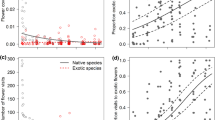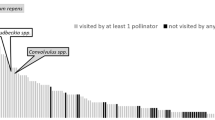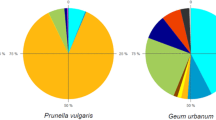Abstract
Urban community gardens are potentially important sites for urban pollinator conservation because of their high density, diversity of flowering plants, and low pesticide use (relative to agricultural spaces). Selective planting of attractive crop plants is a simple and cost-effective strategy for attracting flower visitors to urban green spaces, however, there is limited empirical data about which plants are most attractive. Here, we identified key plant species that were important for supporting flower visitors using a network-based approach that combined metrics of flower visitor abundance and diversity on different crop species. We included a metric of ‘popularity’ which assessed how frequently a particular plant appeared within community gardens. We also determined the impact of garden characteristics such as size, flower species richness, and flower species density on the abundance and diversity of flower visitors. Two plant species, Brassica rapa and Ocimum basilicum were identified as being particularly important species for supporting flower visitor populations. Flower species richness had a strong positive effect on both the abundance and diversity of flower visitors. We suggest that gardeners can maximise the conservation value of their gardens by planting a wide variety of flowering plants including attractive plants such as B. rapa and O. basilicum.



Similar content being viewed by others
References
Baldock KC et al (2019) A systems approach reveals urban pollinator hotspots and conservation opportunities. Nat Ecol Evol 3(3):363–373
Baldock KCR et al (2015) Where is the UK’s pollinator biodiversity? The importance of urban areas for flower-visiting insects. Proc R Soc B Biol Sci 282:20142849. https://doi.org/10.1098/rspb.2014.2849
Benson D, Howell J (1994) The natural vegetation of the Sydney 1: 100 000 map sheet. Royal Botanic Gardens Sydney, Sydney
Bowie MH (1999) Effects of distance from field edge on aphidophagous insects in a wheat crop and observations on trap design and placement. Int J Pest Manag 45:69–73. https://doi.org/10.1080/096708799228076
Cunningham SA, FitzGibbon F, Heard TA (2002) The future of pollinators for Australian agriculture. Aust J Agric Res 53:893–900. https://doi.org/10.1071/AR01186
Dabney SM, Delgado JA, Reeves DW (2001) Using winter cover crops to improve soil and water quality. Commun Soil Sci Plant Anal 32:1221–1250. https://doi.org/10.1081/css-100104110
Dormann CF, Fründ J, Blüthgen N, Gruber B (2009) Indices, graphs and null models: analyzing bipartite ecological networks. The Open Ecol J:2
Elberling H, Olesen JM (1999) The structure of a high latitude plant-flower visitor system: the dominance of flies. Ecography 22:314–323
Garbuzov M, Alton K, Ratnieks FLW (2017) Most ornamental plants on sale in garden centres are unattractive to flower-visiting insects. PeerJ 5:e3066. https://doi.org/10.7717/peerj.3066
Garbuzov M, Ratnieks FL (2013) Quantifying variation among garden plants in attractiveness to bees and other flower-visiting insects. Funct Ecol
Garbuzov M, Samuelson EEW, Ratnieks FLW (2015) Survey of insect visitation of ornamental flowers in Southover Grange garden, Lewes, UK. Insect Sci 22:700–705. https://doi.org/10.1111/1744-7917.12162
Guitart D, Pickering C, Byrne J (2012) Past results and future directions in urban community gardens research. Urban For Urban Green 11:364–373. https://doi.org/10.1016/j.ufug.2012.06.007
Heard T, Hendrikz JK (1993) Factors influencing flight activity of colonies of the stingless bee Trigona-Carbonaria (Hymenoptera, Apidae). Aust J Zool 41:343. https://doi.org/10.1071/ZO9930343
Hennig E, Ghazoul J (2011) Pollinating animals in the urban environment, Urban Ecosyst:15, 149. https://doi.org/10.1007/s11252-011-0202-7
Irshad M (2014) Role of Syrphids (Diptera: Syrphidae) as biotic agents and pollinators in Pakistan. J Bioresour Manag 1(2)
Joshi S, Ballal CR (2013) Syrphid predators for biological control of aphids. J Biol Control 27:151–170
Kevan PG (1972) Insect pollination of high arctic flowers. J Ecol 60:831–847
Latty T, Beekman M (2009) Food quality affects search strategy in the acellular slime mould, Physarum polycephalum. Behav Ecol 20:1160–1167. https://doi.org/10.1093/beheco/arp111
Lawson LJ (2005) City bountiful. A century of community gardening in America. University of California Press, Ltd, Berkeley/Los Angeles/London
Lefebvre V, Fontaine C, Villemant C, Daugeron C (2014) Are empidine dance flies major flower visitors in alpine environments? A case study in the Alps, France. Biol Lett 10:20140742
Majewska A, Altizer S (2018) Planting gardens to support insect pollinators. Conserv Biol
Makinson JC, Threlfall CG, Latty T (2017) Bee-friendly community gardens: impact of environmental variables on the richness and abundance of exotic and native bees. Urban Ecosyst 20:463–476. https://doi.org/10.1007/s11252-016-0607-4
Matteson KC, Langellotto GA (2010) Determinates of inner city butterfly and bee species richness. Urban Ecosyst 13:333–347
Pardee GL, Philpott SM (2014) Native plants are the bee’s knees: local and landscape predictors of bee richness and abundance in backyard gardens. Urban Ecosystems 17:641–659
Pawelek JC, Frankie GW, Thorp RW (2009) Modification of a community garden to attract native bee pollinators in urban San Luis Obispo, California. Cities Environ 2(1):7–21
Pereira ALC, Taques TC, Valim JO, Madureira AP, Campos WG (2015) The management of bee communities by intercropping with flowering basil (Ocimum basilicum) enhances pollination and yield of bell pepper (Capsicum annuum). J Insect Conserv 19:479–486
Quinn GP, Keough MJ (2002) Experimental design and data analysis for biologists. Cambrige University Press, Cambrige
Ratnieks FLW, Garbuzov M (2014) Listmania: the strengths and weaknesses of lists of garden plants to help pollinators. BioScience 64:1019–1026. https://doi.org/10.1093/biosci/biu150
Robinson L (1991) Field guide to the native plants of Sydney. Kangaroo Press, East Roseville
Salisbury A, Armitage J, Bostock H, Perry J, Tatchell M, Thompson K (2015) EDITOR’S CHOICE: enhancing gardens as habitats for flower-visiting aerial insects (pollinators): should we plant native or exotic species? J Appl Ecol 52:1156–1164. https://doi.org/10.1111/1365-2664.12499
Senapathi D, Goddard MA, Kunin WE, Baldock KCR (2017) Landscape impacts on pollinator communities in temperate systems: evidence and knowledge gaps. Funct Ecol 31:26–37. https://doi.org/10.1111/1365-2435.12809
Shakeel M et al (2018) Insect pollinators diversity and abundance in Eruca sativa Mill. (Arugula) and Brassica rapa L. (Field mustard) crops. Saudi J Biol Sci 26(7):1704–1709. https://doi.org/10.1016/j.sjbs.2018.08.012
Soga M, Yamaura Y, Koike S, Gaston KJ (2014) Land sharing vs. land sparing: does the compact city reconcile urban development and biodiversity conservation? J Appl Ecol 51:1378–1386
Ssymank A, Kearns CA, Pape T, Thompson FC (2008) Pollinating flies (Diptera): a major contribution to plant diversity and agricultural production. Biodiversity 9:86–89
Stelzer RJ, Chittka L, Carlton M, Ings TC (2010) Winter active bumblebees (Bombus terrestris) achieve high foraging rates in urban Britain. Plos One 5:7. https://doi.org/10.1371/journal.pone.0009559
Threlfall CG, Walker K, Williams NSG, Hahs AK, Mata L, Stork N, Livesley SJ (2015) The conservation value of urban green space habitats for Australian native bee communities. Biol Conserv 187:240–248. https://doi.org/10.1016/j.biocon.2015.05.003
Turo KJ, Gardiner MM (2019) From potential to practical: conserving bees in urban public green spaces. Fron Ecol Environ 17(3):167–175
Author information
Authors and Affiliations
Corresponding author
Appendices
Appendix 1
Appendix 2
Rights and permissions
About this article
Cite this article
Tasker, P., Reid, C., Young, A.D. et al. If you plant it, they will come: quantifying attractiveness of exotic plants for winter-active flower visitors in community gardens. Urban Ecosyst 23, 345–354 (2020). https://doi.org/10.1007/s11252-019-00914-1
Published:
Issue Date:
DOI: https://doi.org/10.1007/s11252-019-00914-1




